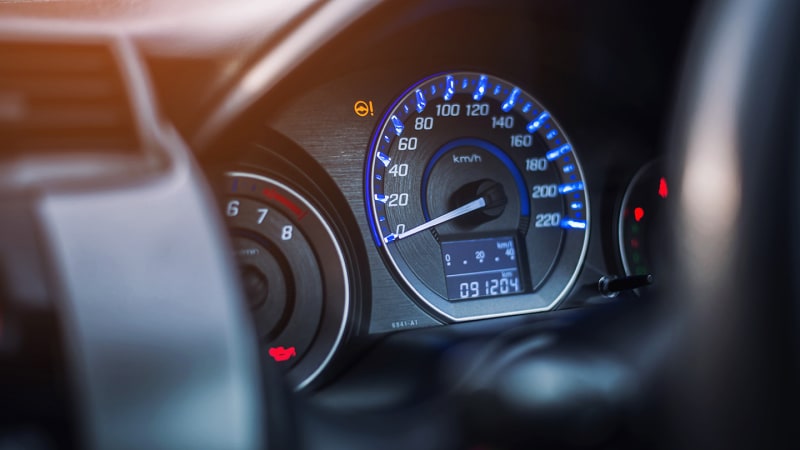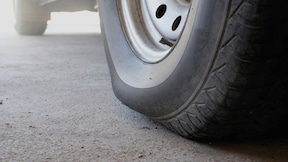What is an odometer and how does it work?

Quick insights
- An odometer is a major device in cars designed to measure and record the total distance your car has traveled.
- Precise odometer readings are critical for determining your car’s current value and protecting you against fraudulent practices such as odometer tampering.
- Verify the accuracy of the odometer reading before finalizing an auto loan agreement. Ensure that the mileage reported on the odometer matches the information provided in the vehicle history report to ensure a fair lending process.
Let’s say you’re about to buy a used car, and you see an odometer reading of 50,000 miles. This number tells you that the vehicle has driven 50,000 miles since it was first used. You can think of the odometer as a trip meter that never resets because it keeps a running tally of all the miles your car has covered. This measurement helps buyers and sellers gauge the car’s usage, providing a key indicator of its overall wear and tear.
What is an odometer?
An odometer is a critical device installed in your vehicle to measure and record the total distance your car has traveled. The readings are important for assessing the deterioration of a car, especially when buying a used car. The odometer provides insight into the car’s overall condition and potential longevity.
There are two primary types of odometers: mechanical and digital (more on this below). Accurate odometer readings play a key role in determining the value of your car and estimating its remaining lifespan. By regularly checking the odometer and adhering to maintenance schedules, you can make better informed decisions and enjoy greater peace of mind throughout your car ownership journey.
How do odometers work?
Odometers serve as vital instruments for tracking the distance your car has traveled; they operate through unique mechanisms depending on their type.
- Mechanical odometers operate through a series of gears and rotating dials. As your car’s wheels turn, they drive a set of gears connected to the odometer. This system counts the wheel rotations and translates them into distance traveled.
- Digital odometers have become increasingly popular in modern cars, offering a sleek, electronic display to present mileage. Digital odometers can offer great precision and may be less susceptible to mechanical failure.
- Digital odometers track a vehicle's distance by using sensors that detect wheel or driveshaft rotations. These sensors generate electrical pluses, which the car’s computer counts and converts into distance (this is displayed digitally). The system provides accurate mileage readings and typically includes additional features such as trip meters.
The transition from mechanical to digital odometers has helped standardize mileage readings across cars, improved the overall reliability of odometer data and enhanced user experience.
Reporting mileage
Ensure the mileage reported on the odometer matches the information provided in the vehicle history report. Address any discrepancies before finalizing the loan agreement. Accurate odometer readings can help you avoid overpaying and make sure the loan terms are fair.
Odometer vs. trip computer
Odometers and trip computers are often seen as similar but serve distinct purposes:
- Odometer: The odometer measures the total distance a vehicle has traveled since it was manufactured. It's a cumulative measure that provides the total mileage of the vehicle. It is useful for tracking overall car usage, maintenance schedules and resale value.
- Trip computer: The trip computer tracks specific information for a single journey or trip. It can display various metrics such as the distance traveled during the trip, fuel efficiency, average speed and sometimes even estimated fuel range. It helps drivers monitor and manage trip-specific data, often resetting after each journey.
Understanding odometer fraud
Odometer fraud is a criminal activity involving the illegal alteration of a car’s odometer to display a lower mileage than the actual distance traveled. This fraudulent practice is used to mislead potential car buyers into believing a car has been driven less than it has, thereby inflating its value and selling price.
Some of the more common techniques for tampering with odometers vary by the type of odometer. In older mechanical models, fraudsters would try to manipulate the gears manually or replace the odometer unit with one showing fewer miles. For digital odometers, fraudsters may use electronic tools or hack the software to change the data stored in the car’s computer system.
The implications of odometer fraud are serious. For prospective used-car buyers, it can lead to purchasing a car that has experienced more wear and tear than the odometer suggests. This could potentially result in unexpected repairs and maintenance costs.
Legal implications of tampering with an odometer
Resetting or rolling back an odometer is illegal under federal law in the United States. Specifically, the Federal Odometer Act prohibits the tampering, resetting or rolling back of odometers with the intent to misrepresent a car’s mileage. This law was created to protect consumers from fraud and ensure error-free vehicle history.
Penalties for odometer tampering can be very severe. Individuals convicted of this offense can face substantial fines and even imprisonment. Penalties can be severe and are determined on a state-by-state basis.
In summary
The odometer is a key tool used for tracking the total distance a vehicle has traveled. It's important to monitor the odometer periodically to keep track of your vehicle usage. When using odometers to make smart car-buying decisions, consider lower odometer readings because they generally experience less wear and tear. Always plan for the long term because car mileage can impact future resale value and long-term usage.



